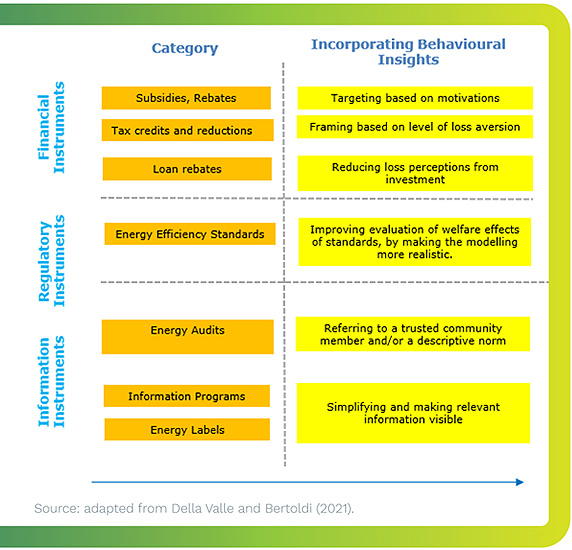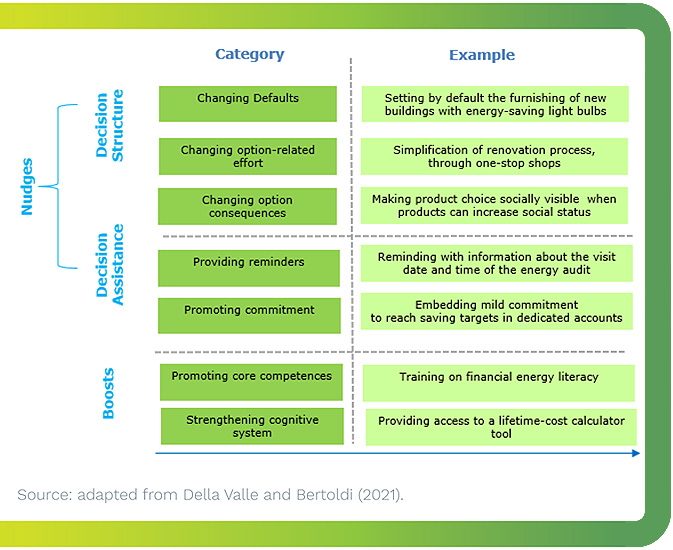In its endeavours to reach climate neutrality by 2050, the European Union identified energy efficiency as a major contributor to achieve decarbonisation. Boosting energy efficiency is a key pillar of the European Green Deal and is, in the building sector, the goal of the Renovation Wave, which also addresses energy poverty. Improving energy efficiency is one of the main objectives of the post-pandemic economic recovery plan as well as of the REPowerEU plan, launched to tackle the energy crisis and to accelerate the transition to more sustainable energy systems, as outlined in the Fit-for-55 package. Finally, energy efficiency measures are being extensively supported through the European Structural and Investment Funds.
The European Union's enabling policy framework and supporting measures for energy efficiency are unparalleled. However, many barriers still prevent citizens from adopting solutions or services that use less energy, leading to the so-called energy efficiency gap.
The energy efficiency gap is a long-debated phenomenon that refers to the difference between the socially desirable rate of energy efficiency investments and that actually observed.
As highlighted in the proposals for recasting the EU Directives on Energy Efficiency and on the Energy Performance of Buildings, many barriers impede energy efficiency investments, including behavioural ones. Thus, to promote energy efficiency uptake, a range of instruments is required, which should also include measures that empower citizens.
Traditionally, the energy efficiency gap was analysed through the lens of neoclassical economics. By associating the energy efficiency gap with market characteristics and failures, such as imperfect information, split incentives, and credit constraints, neoclassical economics provided a rationale for implementing interventions aimed at correcting the market. The underlying assumption was that citizens are rational decision-makers who would always seek the best solution: given that investing in energy efficiency is cost-effective, they would always prefer to do so, once the market failures are remedied, for example by ensuring access to the relevant information.
However, the uptake of energy efficiency is intertwined with many more factors than expected monetary returns and available information.
Behavioural economics can better account for such complexity. As an example, because we actually seek a solution that is good enough, rather than the best one, we systematically fail to assess all the information we have, which can result in ill-informed decisions. Such limited attention is one of the contributors to the energy efficiency gap: we might direct more attention to salient features, such as high prices or subjective negative opinions of peers, and disregard other less salient but crucial attributes, such as low running costs.
The behavioural economic perspective takes into account many other behavioural mechanisms that help explain the energy efficiency gap, such as the tendency to maintain the status quo and the preference for options that provide immediate rather than delayed benefits.
The behavioural economic perspective therefore very usefully complements the economic rationale for interventions with the behavioural one.
This has led to an increased use of behavioural insights in the European policy cycle within a broad range of policy areas, including energy efficiency. Behavioural insights can improve the overall policy impact by enabling adjustments to traditional interventions, such as financial, regulatory and information instruments (Figure 1). As an example, the new generation of energy labels was informed by the experimental evidence that citizens process energy efficiency information more easily if it is framed on the A-to-G scale rather than on the numerical/ alphabetical one.

Fig. 1. How traditional instruments promoting energy efficiency can be complemented by behavioural insights
Behavioural insights can also enrich the policy toolbox with additional instruments, like nudges and boosts (Figure 2).

Fig. 2. Exemplary behavioural instruments for promoting energy efficiency investment decisions
Nudges enable policymakers to address specific behavioural aspects that prevent citizens from investing in energy efficiency by altering the way the decision is presented or by assisting their decision. As an example, one-stop-shops play a central role in the proposals for recasting the EU Directive on the Energy Performance of Buildings, as they can reduce the cognitive effort needed for investing in renovation, thus facilitating the renovation decision. Boosts promote core competencies, empowering citizens to make complex decisions autonomously. As an example, in the proposal for recasting the EU Directive on Energy Efficiency, training activities are considered key to promoting behaviour change: boosting financial literacy in the field of energy can help citizens appreciate the benefits of energy efficiency and make better-informed decisions.
Overall, behavioural insights can better integrate the human factor into energy efficiency policy-making.
However, this integration is only in its infancy. Notably, the potential of instruments like thinks and nudges plus, which could enable citizens to shift from being passive policy recipients to becoming policy codevelopers, remains largely untapped. Thinks are deliberative interventions, where citizens can reflect on a problem and have their say on potential solutions. Nudges plus add the deliberative element of thinks to a nudge, which can result from a co-design process involving different forms of expertise, including citizens and local policymakers. Initiatives such as the Covenant of Mayors, the Energy Communities Repository and the Rural Energy Community Advisory Hub already showcase good practices on how to foster this bottom-up approach. More particularly, the Clean Energy Package represented a turning point for the development and diffusion of energy communities in Europe as places where pro-environmental consumption practices and deliberation take place.